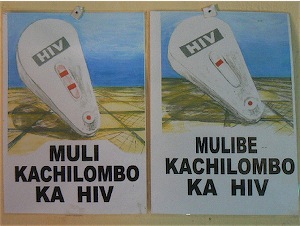Hearing the News that “You Are Positive”
“Malawi doesn’t have the same strictness about privacy that we have in the US,” I tried to explain to my guest from America as we both stiffly watched the scene unfold before us. A nurse who was showing us around the clinic had seated us in a little testing room a few minutes earlier. And now to our shock she was giving a lady a test to see if she had HIV right there in front of us. Several other strangers, all waiting their turn, were also crowded in the room, some sitting so close to the lady that they could have reached out and touched her as she braced herself for the results.
The test works like one of those instant pregnancy kits. A nurse captures a drop of your blood on a pear shaped plastic card and a few minutes later-Presto!- the verdict comes in. If only one bar appears on the card that means you tested negative for the virus and you’re free. Life will go on as normal.
Two bars mean you just tested positive for HIV!
“You are positive,” as they say here. You officially have the ghastly HIV virus that leads to AIDS and are staring the totality of its nightmare of horrific illness, stigma, and slow but early death right in the eye.
All who come for testing arrive with a sense of dread, terrified that they will test positive for the virus, but most come out with a new spring in their step and hope for the future after learning that they are not infected after all. Some, though, come out devastated, having received the dreadful confirmation that their worst fears have come true: their life is over as they know it-and that it will probably be a lot shorter at that.
The last thing I wanted was to be present the moment when this lady, or anyone else, learned their HIV status, especially if it was bad news. But it would have been offensive to storm out now, practically stepping over the lady’s feet. I tried not to listen to what the nurse was saying in low tones to her, but the formal rehearsed sound of the voice was not encouraging. A quick glance at the woman’s emotionless face, skin taut over her cheekbones, dark eyes staring blankly into space, told me she was not getting the news she wanted. No, she looked like she had just received the kind of news that makes you feel like a 20-ton Mack truck has just dumped its whole load of rock on you.
Now they were testing her a second time. And why would they do that? I suspect that you can figure that out. But these little tests are so accurate that there was little doubt her fate was sealed and the nurse confirmed this fact to me the next time we met.
They didn’t reveal to me the woman’s name and I can’t tell you any more specifics of her story. We could only speculate about what was going through her mind when she heard the news. What would this do to her marriage if she had been infected by her husband as is so often the case? How would her kids learn about this? Did she have the emotional strength to fight this with the life-prolonging drugs available these days or would this news just destroy her hope and will to go on living?

“You are positive.”
Society stigmatizes the disease so greatly that almost no one admits they have it even if they know. Nobody has ever told me, “I have AIDS,” or “I am HIV positive.” Instead all these young people who are wasting away and dying in our community officially are being killed by other illnesses. It’s true that other diseases finish the immune deficient patients off, but the real cause, AIDS, usually lurks close by in the shadows.
My friend and I left the testing clinic after a few minutes and went on our way, but now any easy conversation that would take our minds off of what we had just seen eluded us. We had not counted on being witnesses to such a grave moment in this stranger’s life. Never mind the fact that I certainly interact with HIV positive individuals on a daily basis, it’s a lot easier not knowing who they are or being forced to consider what the future holds for them.
In the Photo: The left poster explains what the test means when two bars show: “The HIV virus is present.” The right poster showing one bar says, “The HIV virus is not present.”
.
